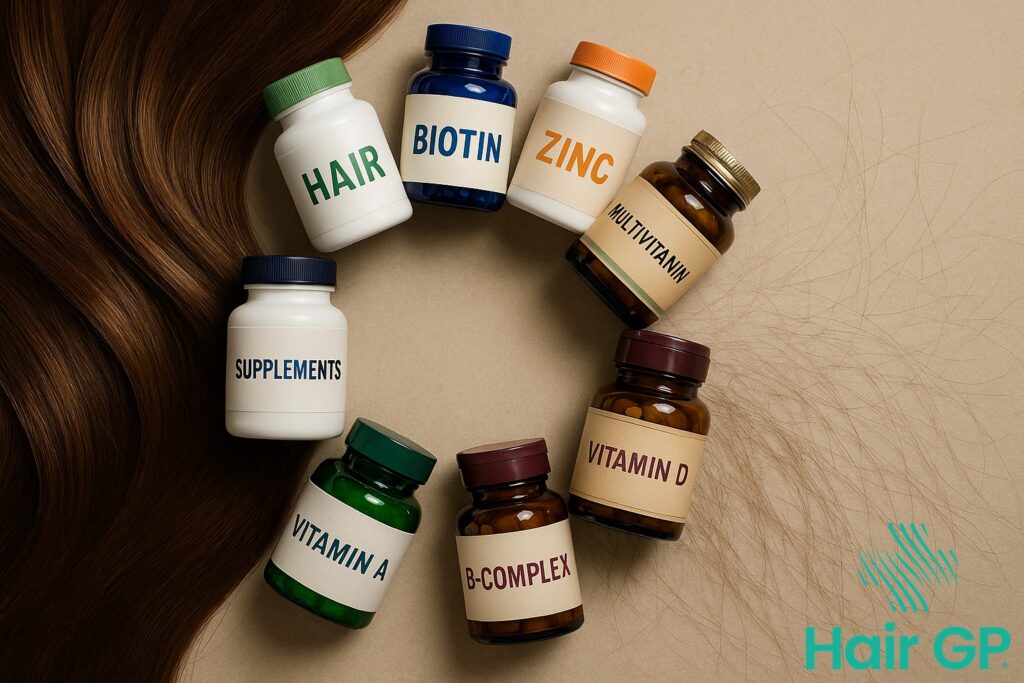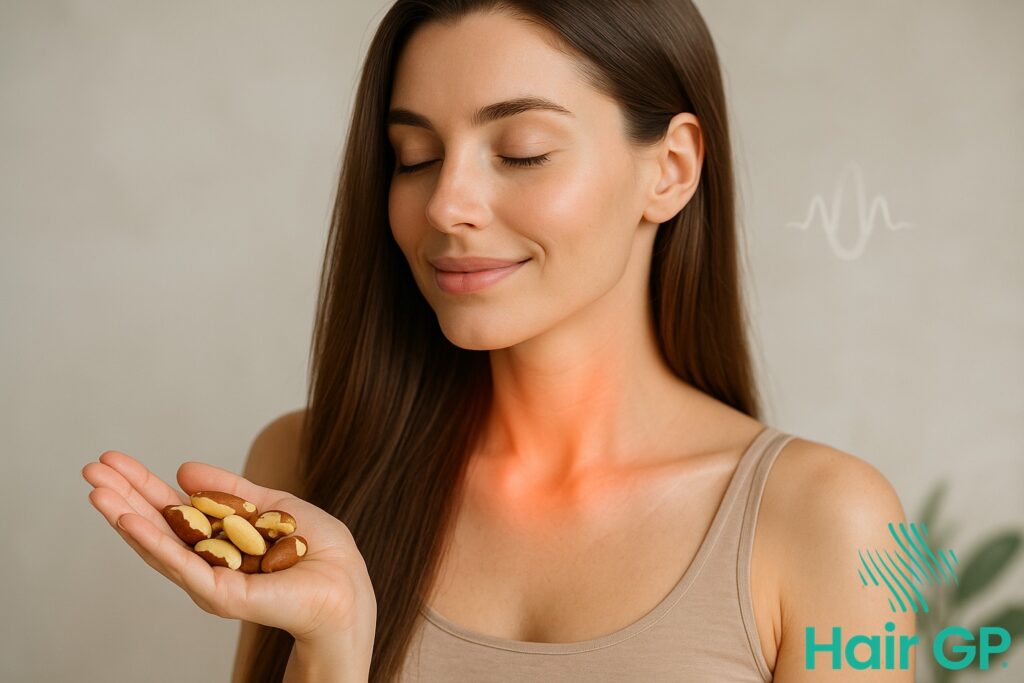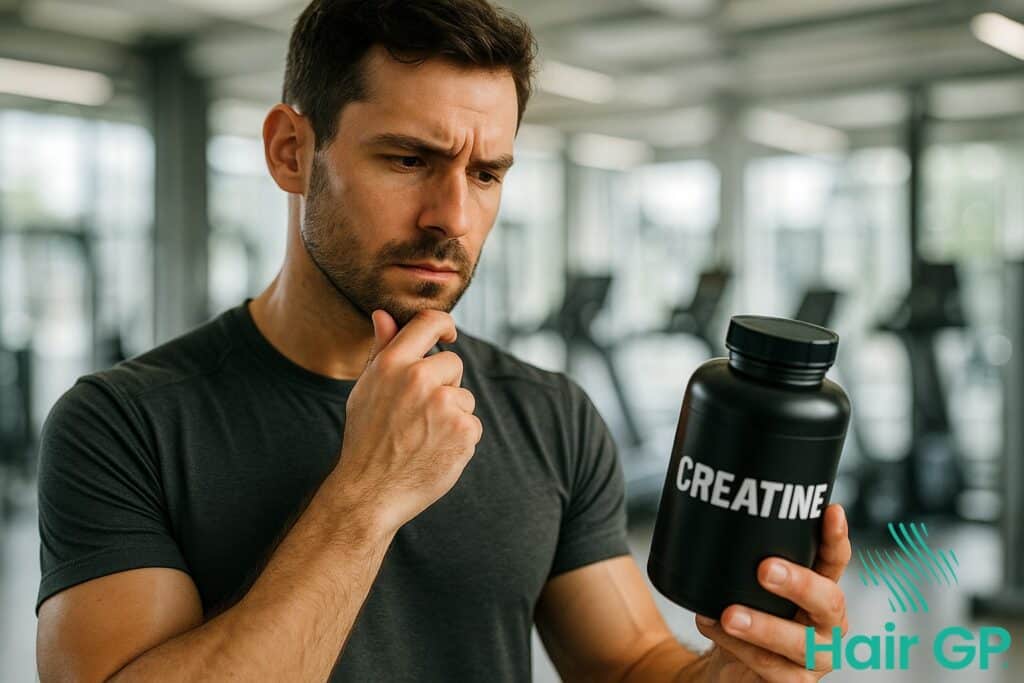Introduction
For millions of people experiencing hair loss, supplements promise a natural solution to restore healthy hair growth. Yet in a surprising twist, some of these very products designed to promote hair growth can actually trigger the opposite effect when misused. This paradoxical relationship between supplements and hair health reveals an important truth: more isn’t always better when it comes to nutrition.
Whilst proper supplementation can support hair growth, excessive doses or certain combinations can disrupt the delicate balance your hair follicles need to thrive. From vitamin toxicity that damages hair roots to hormonal imbalances that accelerate genetic hair loss patterns, the world of hair loss supplements is filled with potential pitfalls that many consumers never see coming.
This comprehensive guide explores the biological mechanisms behind supplement-induced hair loss, examining how common vitamins, minerals, and speciality products can backfire when taken incorrectly. We’ll investigate everything from vitamin A toxicity and protein supplement imbalances to the hidden dangers of weight loss products and hormonal boosters. You’ll discover how both deficiencies and excesses of key nutrients like iron can damage your hair, and why antioxidant overload might be sabotaging your efforts.
Most importantly, we’ll provide evidence-based guidelines for safe supplementation that supports rather than hinders healthy hair growth. Whether you’re currently experiencing hair loss or simply want to protect your hair whilst taking supplements, this article offers the knowledge you need to make informed decisions about your hair health journey.
Key Takeaways – TL/DR
- Excessive vitamin A, selenium, and vitamin E supplementation can trigger telogen effluvium and hair shedding
- Weight loss supplements containing stimulants may disrupt the natural hair growth cycle
- Iron overload from supplements can paradoxically cause hair loss similar to iron deficiency
- Proper dosing and medical consultation are essential before starting any hair loss supplements
- Some herbal supplements interact with medications and hormones, leading to unexpected hair loss
The Surprising Connection Between Supplements and Hair Loss
Supplements designed to enhance hair health can paradoxically trigger hair loss when improperly used, creating a complex relationship between nutritional intake and follicle function. Understanding how nutrients interact with the natural hair growth cycle reveals why both deficiencies and excesses can disrupt normal hair production, potentially leading to conditions like telogen effluvium and various forms of alopecia.
Understanding the Hair Growth Cycle
The natural hair growth cycle consists of three distinct phases that each follicle undergoes independently. During the anagen phase, which typically lasts between two to seven years, hair actively grows at approximately 1.25 centimetres per month [1]. This growth phase determines ultimate hair length and involves rapid cell division within the follicle bulb.
Following anagen, the hair cycle transitions into the catagen phase, a brief transitional period lasting roughly two to three weeks. During this time, the follicle shrinks and detaches from its blood supply, preparing for eventual shedding. The final telogen phase sees the follicle rest for approximately three months before releasing the hair shaft.
Normal shedding patterns involve losing 50 to 100 hairs daily as follicles naturally progress through these phases. However, various disruption triggers can synchronise large numbers of follicles, pushing them prematurely into telogen. Telogen effluvium, affecting up to 50% of individuals at some point, occurs when this synchronisation causes excessive shedding two to three months after a triggering event [2].
How Nutrients Affect Hair Follicles
Hair follicles rank amongst the body’s most metabolically active structures, requiring consistent nutrient delivery through specialised pathways. Essential vitamins and minerals support follicle metabolism by facilitating protein synthesis, cellular energy production, and antioxidant defence mechanisms. Iron, for instance, enables oxygen transport to rapidly dividing follicular cells, whilst B-complex vitamins support keratin production.
The delicate balance between deficiency and excess profoundly impacts follicular function. Insufficient nutrients can prematurely shift follicles from anagen to telogen, manifesting as diffuse alopecia. Conversely, excessive supplementation, particularly with fat-soluble vitamins like vitamin A, can paradoxically trigger similar hair loss patterns by disrupting normal cellular processes.
Follicle metabolism depends on precise nutrient concentrations to maintain the hair cycle’s intricate timing. Zinc supports DNA and RNA synthesis crucial for follicular cell division, whilst biotin aids in fatty acid metabolism necessary for healthy hair shaft formation. When supplement doses exceed physiological requirements, these same nutrients can interfere with other essential minerals’ absorption or create toxic metabolic conditions within the follicle microenvironment, ultimately compromising hair growth rather than enhancing it.

Vitamin A: The Hidden Hair Loss Culprit
Whilst vitamin A plays a crucial role in healthy hair growth, excessive supplementation can paradoxically trigger significant hair shedding and loss. This fat-soluble vitamin, when consumed beyond safe thresholds, accumulates in the body and disrupts the delicate balance of cellular processes within hair follicles, leading to telogen effluvium and potentially permanent hair loss.
Vitamin A toxicity, or hypervitaminosis A, occurs when serum retinol levels exceed 100 μg/dL, typically resulting from daily intake above 25,000 IU for extended periods [3]. The mechanism involves disruption of normal keratinocyte differentiation and proliferation within the hair follicle matrix, forcing actively growing hairs into premature resting phases. Unlike water-soluble vitamins that are readily excreted, vitamin A accumulates in hepatic stellate cells, creating a reservoir that continues releasing toxic levels even after supplementation stops.
Signs of Vitamin A Overdose
Beyond hair shedding, vitamin A toxicity manifests through multiple systemic symptoms that serve as warning signs. Early indicators include persistent headaches, blurred vision, and skin changes such as dryness, peeling, and photosensitivity [4]. As toxicity progresses, individuals may experience bone pain, joint stiffness, and elevated liver enzymes, reflecting the vitamin’s widespread effects on various organ systems.
The dosage threshold for toxicity varies considerably based on individual factors, including liver function, body weight, and concurrent medications. Chronic toxicity typically develops with daily intake exceeding 10,000 IU for adults, though some individuals show symptoms at lower doses. Risk factors that increase susceptibility include pre-existing liver conditions, alcohol consumption, and concurrent use of retinoid medications such as isotretinoin.
Excessive shedding from vitamin A toxicity often begins 2-3 months after initiating high-dose supplementation, as the hair growth cycle requires time to manifest disruptions. This delayed onset frequently masks the connection between supplementation and hair loss, leading many to increase their vitamin intake rather than recognising it as the underlying cause.
Safe Vitamin A Dosing for Hair Health
The recommended dietary allowance (RDA) for vitamin A stands at 800 μg RAE for men and 700 μg RAE for women, equivalent to approximately 3,000 IU and 2,333 IU respectively [5]. These levels support optimal hair follicle function without risking accumulation and subsequent side effects. However if you have a balanced diet you shouldn’t need a supplement at all. Pregnant women or those trying for a baby require special consideration, as vitamin A toxicity poses teratogenic risks alongside possible side effects on maternal hair health.
Natural food sources provide the safest approach to meeting vitamin A requirements. Beta-carotene from colourful vegetables like carrots, sweet potatoes, and spinach converts to vitamin A as needed, preventing toxic accumulation. Animal sources such as liver, whilst rich in preformed vitamin A, require careful portion control to avoid excessive intake.
When considering supplements, choosing products containing mixed carotenoids rather than retinol palmitate or retinyl acetate reduces toxicity risk. If supplementation is necessary, limiting intake to 3,000 IU daily provides adequate support without approaching dangerous thresholds. Regular monitoring through blood tests can identify rising retinol levels before clinical symptoms, including permanent hair loss, develop.
Protein and Amino Acid Supplements: When Too Much Backfires
Whilst adequate protein intake remains fundamental for healthy hair growth, excessive supplementation can paradoxically trigger hair loss through complex biochemical mechanisms. Hair follicles require approximately 1.2-1.5 grams of protein per kilogram of body weight daily for optimal function, yet many fitness enthusiasts consume two to three times this amount through supplements [6]. This overconsumption disrupts the delicate amino acid balance essential for follicular health, potentially accelerating hair thinning and premature balding.
The relationship between high-protein supplementation and androgenetic alopecia emerges through several interconnected pathways. Excessive protein intake, particularly from whey-based supplements, can elevate insulin-like growth factor 1 (IGF-1) levels, which subsequently increases androgen activity in genetically susceptible individuals. This hormonal cascade intensifies the conversion of testosterone to dihydrotestosterone (DHT), the primary culprit in male pattern baldness. Moreover, branched-chain amino acids (BCAAs), popular amongst bodybuilders, may further exacerbate this process by stimulating mTOR pathways that sensitise follicles to androgens.
Amino acid imbalances created by concentrated protein supplements present another mechanism for hair loss. When single amino acids or specific combinations dominate dietary intake, competitive inhibition occurs at absorption sites, potentially creating deficiencies in other essential amino acids crucial for keratin synthesis. Lysine and methionine, both vital for hair structure, can become relatively deficient despite adequate total protein consumption. This imbalance manifests as brittle, thinning hair that progressively weakens over time.
The bodybuilding community’s preference for creatine-enhanced protein formulations introduces additional risks for those predisposed to lose hair. Research indicates that creatine supplementation can increase DHT levels by up to 56%, significantly accelerating the progression of androgenetic alopecia in susceptible individuals [7]. This effect, combined with the anabolic environment created by excessive protein intake, creates a perfect storm for premature balding, particularly in men aged 20-35 who comprise the primary demographic for such supplements.
Understanding these mechanisms allows for more informed supplementation strategies. Rather than eliminating protein supplements entirely, individuals concerned about hair thinning should moderate intake to align with actual physiological needs. Cycling protein supplementation, diversifying protein sources, and monitoring for early signs of hormonal changes can help maintain the benefits of adequate protein whilst minimising risks to follicular health. Additionally, those with family histories of male pattern baldness should exercise particular caution with high-dose protein regimens, as genetic predisposition amplifies the negative effects of supplement-induced hormonal fluctuations on hair follicles.
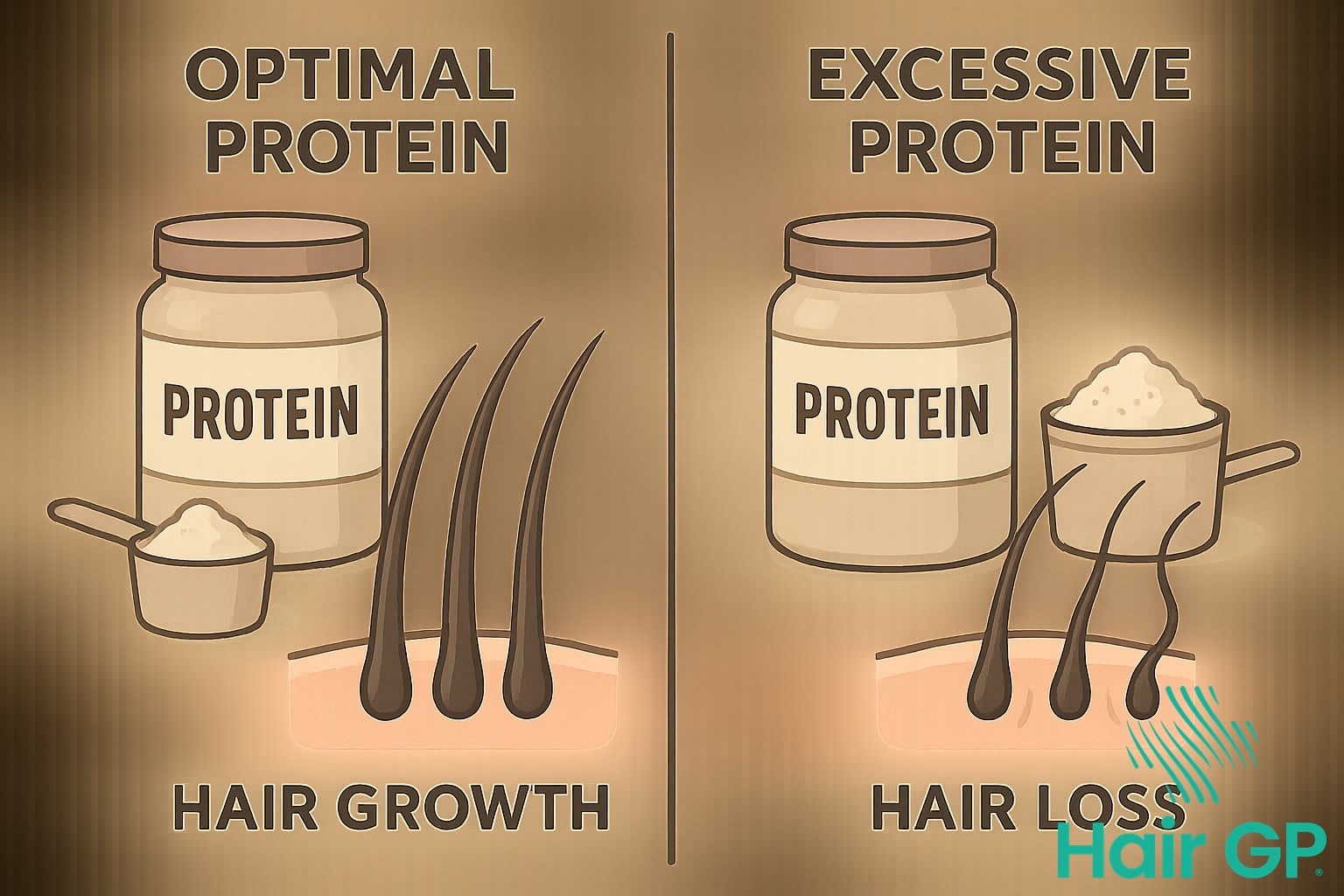
Iron Supplements and Hair Health: A Delicate Balance
Iron represents one of the most critical yet misunderstood essential vitamins and minerals for maintaining optimal hair health. This mineral plays a fundamental role in haemoglobin production and oxygen delivery to hair follicles, making it indispensable for proper hair growth. However, maintaining appropriate iron levels requires careful balance, as both deficiency and excess can paradoxically lead to significant hair fall.
Iron deficiency remains one of the most common nutritional causes of hair loss, particularly affecting premenopausal women. Research indicates that ferritin levels below 40 ng/mL correlate strongly with increased hair shedding and may exacerbate female pattern hair loss [8]. The mechanism involves reduced oxygen delivery to rapidly dividing follicular cells, disrupting the anagen phase and precipitating premature entry into telogen. Women experiencing heavy menstrual periods, vegetarians, and frequent blood donors face heightened risk of developing iron-deficiency-related hair loss.
Conversely, excessive iron supplementation poses equally concerning risks for hair health. Iron overload conditions, whether from genetic haemochromatosis or aggressive supplementation, can generate oxidative stress within hair follicles, leading to inflammation and follicular damage [9]. This oxidative damage manifests as brittle, thinning hair that progressively loses its lustre and strength. The paradox of iron supplementation becomes evident when well-meaning attempts to treat hair loss through high-dose iron inadvertently worsen the condition.
Proper assessment requires comprehensive testing beyond simple haemoglobin measurements. Ferritin levels provide the most accurate reflection of iron stores, whilst transferrin saturation helps identify potential overload. Optimal ferritin ranges for hair health typically fall between 70-90 ng/mL, though individual variations exist based on genetics and overall health status.
Safe supplementation strategies emphasise gradual repletion under professional guidance. Iron bisglycinate offers superior absorption with reduced gastrointestinal effects compared to ferrous sulphate. Taking iron supplements with vitamin C enhances absorption, whilst avoiding concurrent consumption with calcium, tea, or coffee prevents interference. Dosing typically ranges from 18-45mg daily, adjusted based on regular monitoring of iron indices.
The timeline for improvement varies considerably, with most individuals requiring 3-6 months of appropriate supplementation before observing reduced shedding and improved hair quality. Patience proves essential, as premature discontinuation or excessive dosing frequently undermines therapeutic success. Regular monitoring every 8-12 weeks ensures levels remain within optimal ranges whilst preventing inadvertent overload, ultimately supporting sustainable hair health through balanced iron status.
Vitamin E and Selenium: Antioxidant Overload
The paradoxical relationship between antioxidants and hair health becomes apparent when examining excessive vitamin E and selenium supplementation. Whilst moderate doses support follicular function, supraphysiological levels create an environment that actually promotes oxidative damage through disruption of cellular redox balance. High-dose vitamin E supplementation, particularly exceeding 400 IU daily, interferes with the natural oxidative signalling necessary for hair follicle cycling, potentially triggering premature catagen phase entry and subsequent hair loss.
Selenium toxicity represents a particularly concerning example of antioxidant overload affecting hair health. Doses exceeding 200 micrograms daily can accumulate in hair follicles, disrupting keratinocyte function and causing characteristic brittleness followed by diffuse shedding. The mechanism involves selenium’s interference with sulphur-containing amino acids essential for keratin cross-linking, creating structurally compromised hair shafts that break easily. In severe cases, this can progress to patchy hair loss resembling alopecia areata, though the underlying pathophysiology differs significantly from autoimmune-mediated hair loss.
The antioxidant paradox extends beyond direct follicular damage. Excessive vitamin E and selenium create a reductive stress environment that impairs normal cellular signalling pathways required to stimulate hair growth. This disrupts the delicate balance between reactive oxygen species as signalling molecules and their role as cellular stressors. The following side effects frequently manifest: telogen effluvium, reduced hair diameter, and altered pigmentation patterns. These changes often develop gradually, making correlation with supplementation difficult to establish without careful history-taking.
Contemporary hair products frequently incorporate antioxidant complexes marketed for follicular protection, yet their interaction with oral supplements remains poorly understood. The cumulative effect of topical and systemic antioxidant exposure can overwhelm cellular regulatory mechanisms, creating unexpected toxicity. Research indicates that selenium concentrations in hair products, when combined with oral supplementation, may exceed safe thresholds for follicular health. Other side effects include scalp irritation, altered sebum production, and compromised barrier function.
Optimal antioxidant balance requires careful consideration of total exposure from all sources. The therapeutic window for both vitamin E and selenium remains narrow, with benefits quickly transitioning to harm at elevated doses. Clinical evidence suggests maintaining vitamin E below 150 IU daily and selenium under 55 micrograms provides adequate antioxidant support without risking follicular damage. This balanced approach supports the natural oxidative processes essential for healthy hair growth whilst preventing excessive free radical damage.
Weight Loss Supplements That Trigger Hair Loss
The pursuit of rapid weight loss through dietary supplements often comes with an unexpected consequence: significant hair thinning and loss. Many popular thermogenic formulas, appetite suppressants, and metabolism boosters can severely disrupt normal hair growth cycles, leading to temporary or even permanent damage to the hairline and overall hair density.
Stimulant-Based Supplements and Hair Loss
Stimulant-heavy weight loss supplements, particularly those containing high concentrations of caffeine and ephedra-like compounds, can trigger substantial hair thinning through multiple mechanisms. These substances activate the body’s stress response system, flooding the bloodstream with cortisol and other stress hormones that directly interfere with hair follicle function [10]. Elevated cortisol levels force hair follicles into premature resting phases, disrupting the normal growth cycle and causing diffuse shedding across the scalp.
Beyond the stress response, stimulant-based supplements often cause severe nutrient depletion through increased metabolic demands and appetite suppression. The body prioritises vital organ function over hair growth during periods of nutritional stress, redirecting limited resources away from follicles. This nutritional diversion particularly affects women, who may experience patterns resembling female pattern baldness when combining stimulant use with calorie restriction. Some herbal supplements marketed as ‘natural’ alternatives contain compounds that mimic these stimulant effects, producing similar disruptions to hair growth despite their plant-based origins.
Rapid Weight Loss and Telogen Effluvium
Crash dieting supplements that promise dramatic weight loss frequently trigger telogen effluvium, a condition where large numbers of hair follicles simultaneously enter the resting phase [11]. This nutritional shock occurs when the body interprets rapid weight loss as a survival threat, shutting down non-essential functions including hair production. The resulting shedding typically begins two to three months after starting aggressive supplementation, with individuals losing up to 300 hairs daily compared to the normal 50-100.
Recovery timelines vary considerably, but most people experience continued shedding for three to six months after discontinuing crash diet supplements. Prevention strategies focus on gradual, sustainable weight loss approaches that maintain adequate nutrition whilst avoiding extreme metabolic stress. Nutritional support during recovery proves crucial, with particular emphasis on protein intake, B-complex vitamins, and minerals essential for follicle regeneration.
The connection between aggressive weight loss supplementation and conditions like androgenic alopecia remains concerning, as metabolic disruptions can unmask genetic predispositions to pattern hair loss. Women experiencing supplement-induced shedding may notice permanent changes to their hairline density, particularly if underlying hormonal imbalances exist. Understanding these risks enables informed decisions about weight management approaches that protect long-term hair health whilst achieving sustainable body composition goals.
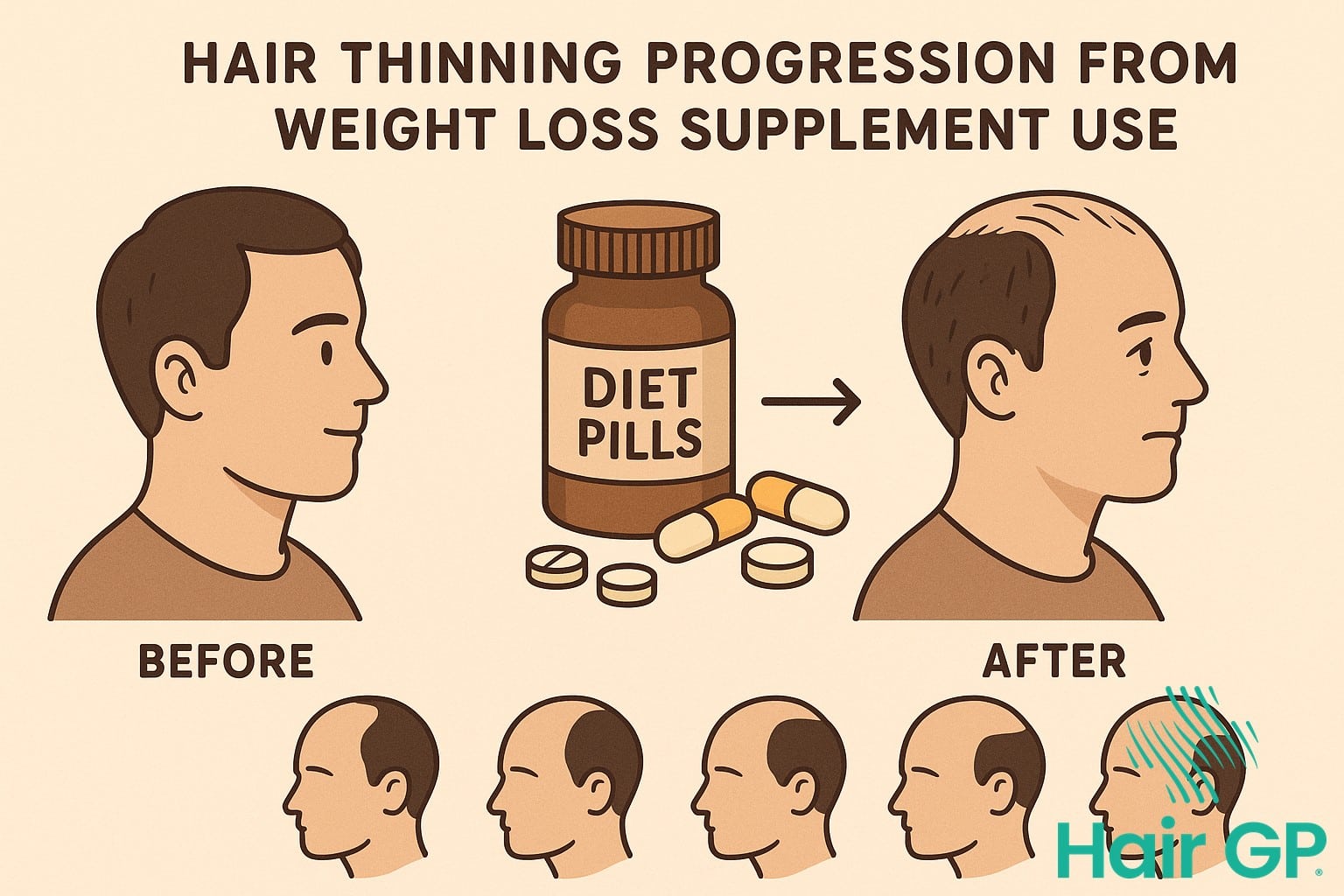
Hormonal Supplements and Hair Changes
Hormonal supplements significantly influence hair growth patterns through complex endocrine mechanisms that often accelerate existing genetic predispositions to hair loss. These supplements, ranging from DHEA to testosterone boosters, can trigger profound hormonal changes that manifest as alterations in hair density, growth rate, and follicular health, particularly in individuals with underlying androgenetic alopecia susceptibility.
DHEA and Testosterone Boosters
Dehydroepiandrosterone (DHEA) supplementation presents particular risks for hair health through its conversion to more potent androgens. DHEA undergoes enzymatic transformation to testosterone and subsequently to dihydrotestosterone (DHT), the primary hormone implicated in pattern hair loss [12]. This conversion occurs through 5α-reductase activity in hair follicles, creating localised hormonal environments that miniaturise follicles in genetically susceptible individuals.
Gender differences profoundly influence DHEA’s impact on hair. Males typically experience accelerated frontal recession and vertex thinning, whilst females may develop diffuse thinning patterns with preserved frontal hairlines. Genetic predisposition determines individual sensitivity, with those carrying androgen receptor gene polymorphisms experiencing more pronounced effects. Testosterone boosters containing tribulus terrestris, D-aspartic acid, or fenugreek extracts similarly elevate systemic androgen levels, potentially overwhelming the protective effects of medications like finasteride in those attempting to prevent hair loss.
The relationship between supplemental hormones and hair regrowth remains complex. Whilst some individuals report initial improvements in hair quality, prolonged use often accelerates miniaturisation in predisposed follicles. This paradox highlights the importance of genetic testing and hormonal profiling before initiating any hormone-affecting supplementation regimen [13].
Biotin Myths and Realities
Biotin supplementation represents one of the most misunderstood interventions in hair health. True biotin deficiency remains exceptionally rare in developed countries, occurring primarily in individuals with biotinidase deficiency or prolonged raw egg white consumption. Despite marketing claims, mega-doses of biotin demonstrate no benefit for hair regrowth in individuals with normal baseline levels.
Overdose effects from biotin supplementation extend beyond simple inefficacy. High-dose biotin interferes with numerous laboratory assays, including thyroid function tests, cardiac markers (for heart attacks), and hormone panels. This interference can mask underlying conditions contributing to hair loss or lead to misdiagnosis of thyroid disorders, potentially delaying appropriate treatment.
The biotin-dandruff connection represents another misconception. Whilst biotin deficiency can cause seborrhoeic dermatitis-like symptoms, supplementation in replete individuals offers no benefit for dandruff control. Some individuals report increased scalp oiliness with high-dose biotin, potentially exacerbating existing seborrhoeic conditions.
Contemporary evidence suggests that addressing hormonal imbalances through targeted interventions, rather than broad supplementation, provides superior outcomes. Combining treatments like oral minoxidil with appropriate hormonal modulation offers more predictable results than relying on over-the-counter hormonal supplements with variable potency and unpredictable effects on hair follicle biology.
Safe Supplementation Guidelines for Hair Health
Supporting healthy hair growth through supplementation requires a balanced, informed approach that prioritises safety whilst maximising potential benefits. Understanding proper dosing, timing, and potential interactions helps prevent hair loss complications that can arise from well-intentioned but misguided supplement routines. The key lies in recognising that more isn’t always better when it comes to hair health nutrients.
At Hair GP we generally recommend a balanced diet over supplement use (with the exception of vitamin D or when a doctor has asked you to take some for a known deficiency). However if you do want to take them then starting with appropriate doses represents the foundation of safe supplementation. Gradually introducing supplements allows your body to adjust and helps identify any adverse reactions early. Taking supplements with meals improves absorption whilst reducing the risk of digestive discomfort, particularly with iron and zinc preparations that can cause stomach upset when taken on an empty stomach.
Timing matters considerably when combining multiple supplements to prevent hair loss. Spacing iron and zinc intake by at least two hours prevents competition for absorption, whilst calcium can interfere with iron uptake when taken simultaneously. Fat-soluble vitamins like A, D, E, and K should be consumed with meals containing healthy fats for optimal absorption. Water-soluble nutrients, including B-complex vitamins and vitamin C, can be taken throughout the day as excess amounts are typically excreted rather than stored.
Certain combinations require particular caution to ensure supplements for hair loss work effectively without causing harm. High doses of vitamin E can interfere with blood clotting, especially problematic when combined with other medications like aspirin or warfarin. Excessive vitamin A supplementation alongside retinoid skincare products may lead to toxicity symptoms, including paradoxical hair loss. Similarly, combining multiple sources of iron without professional guidance risks dangerous accumulation in body tissues.
Recognising when professional guidance becomes necessary protects against serious complications whilst ensuring optimal results. Persistent hair loss despite consistent supplementation, unusual symptoms after starting new supplements, or existing health conditions warrant consultation with healthcare providers. They can assess potential interactions with other medications, recommend appropriate testing for nutrient deficiencies, and develop personalised supplementation strategies based on individual needs. Additionally, sudden or patchy hair loss, scalp pain, or accompanying symptoms like fatigue or weight changes require professional evaluation as they may indicate underlying conditions requiring specific treatment beyond basic supplementation.
Alternative Treatment Options for Healthy Hair
Fortunately, several evidence-based treatment options exist that can effectively promote hair growth without the risks associated with unregulated supplements. These scientifically proven approaches offer safer pathways to healthier hair whilst avoiding potentially harmful interactions and side effects.
Minoxidil stands as the most extensively researched topical treatment to treat hair loss, with decades of clinical evidence supporting its efficacy. Available in both 2% and 5% formulations, this medication works by improving blood flow to hair follicles and extending the growth phase of the hair cycle. Unlike oral supplements that affect entire body systems, topical minoxidil targets specific areas, minimising systemic exposure whilst delivering measurable results.
Beyond pharmaceutical interventions, lifestyle modifications can significantly stimulate hair growth naturally. Regular scalp massage increases circulation to follicles, whilst stress reduction through meditation or yoga helps regulate hormones that influence hair health. Quality sleep patterns and regular exercise contribute to optimal nutrient delivery and cellular regeneration essential for robust hair growth.
Dietary approaches offer another safe avenue for supporting hair health. Rather than relying on concentrated supplements, obtaining nutrients through whole foods ensures balanced absorption and reduces overdose risks. Iron-rich leafy greens, omega-3 fatty acids from fish, and biotin from eggs provide essential building blocks for healthy hair. Additionally, choosing gentle hair products free from harsh chemicals prevents unnecessary damage and breakage.
These evidence-based alternatives demonstrate that effective hair care needn’t involve risky supplementation. By combining proven treatments with healthy lifestyle choices, individuals can achieve their hair goals safely and sustainably.
Conclusion
The journey to healthy hair growth through supplementation requires careful consideration rather than a more-is-better approach. Whilst hair loss supplements can support follicle health when used appropriately, excessive intake may paradoxically trigger the very issues they aim to prevent. Understanding the delicate balance between nutritional support and potential toxicity remains crucial for anyone seeking to prevent hair loss through dietary intervention.
Professional guidance proves invaluable when navigating treatment options for hair health concerns. Doctors can assess individual nutrient status, identify underlying causes of hair loss, and recommend appropriate supplementation protocols tailored to specific needs. This personalised approach minimises risks whilst maximising the potential benefits of supplements for hair restoration.
Success in maintaining optimal hair health ultimately depends on adopting a comprehensive strategy that combines appropriate supplementation with proper diet, stress management, and scalp care. Rather than relying solely on high-dose supplements, individuals should focus on achieving nutritional balance through varied food sources supplemented only as necessary. By respecting the body’s complex regulatory systems and seeking professional advice when needed, one can develop a sustainable approach to hair care that promotes genuine, lasting results without compromising overall health.
Frequently Asked Questions
Yes, excessive intake of certain vitamins, particularly vitamin A, vitamin E, and selenium, can trigger hair loss through various mechanisms including follicle damage and disruption of the hair growth cycle. This condition, often presenting as telogen effluvium, typically occurs when supplement doses far exceed recommended daily allowances.
Hair regrowth typically begins 3-6 months after discontinuing the problematic supplement, as hair follicles need time to recover and re-enter the growth phase. Complete recovery may take 6-12 months, depending on the severity of the damage and individual factors.
Safe hair growth supplements include appropriate doses of biotin (30-100mcg daily), iron (for those with confirmed deficiency), zinc (8-11mg daily), and vitamin D (600-800 IU daily). Always consult a healthcare provider before starting any supplement regimen.
Not necessarily. First, review your supplement doses with a healthcare provider to identify potential culprits. Blood tests can help determine if you have toxic levels of certain nutrients. Gradually reduce or eliminate supplements one at a time to identify the cause.
References
- Hoover E, Alhajj M, Flores JL. Physiology, Hair. StatPearls. 2023.
- Asghar F, Shamim N, Farooque U, Sheikh H, Aqeel R. Telogen Effluvium: A Review of the Literature. Cureus. 2020;12(5):e8320.
- Geubel AP, De Galocsy C, Alves N, Rahier J, Dive C. Liver damage caused by therapeutic vitamin A administration: estimate of dose-related toxicity in 41 cases. Gastroenterology. 1991;100(6):1701-1709.
- Penniston KL, Tanumihardjo SA. The acute and chronic toxic effects of vitamin A. Am J Clin Nutr. 2006;83(2):191-201.
- Institute of Medicine (US) Panel on Micronutrients. Dietary Reference Intakes for Vitamin A, Vitamin K, Arsenic, Boron, Chromium, Copper, Iodine, Iron, Manganese, Molybdenum, Nickel, Silicon, Vanadium, and Zinc. Washington (DC): National Academies Press (US); 2001.
- Guo EL, Katta R. Diet and hair loss: effects of nutrient deficiency and supplement use. Dermatol Pract Concept. 2017;7(1):1-10.
- van der Merwe J, Brooks NE, Myburgh KH. Three weeks of creatine monohydrate supplementation affects dihydrotestosterone to testosterone ratio in college-aged rugby players. Clin J Sport Med. 2009;19(5):399-404.
- Trost LB, Bergfeld WF, Calogeras E. The diagnosis and treatment of iron deficiency and its potential relationship to hair loss. J Am Acad Dermatol. 2006;54(5):824-844.
- Almohanna HM, Ahmed AA, Tsatalis JP, Tosti A. The Role of Vitamins and Minerals in Hair Loss: A Review. Dermatol Ther (Heidelb). 2019;9(1):51-70.
- PubMed source 33420494
- PubMed source 35620774
- Trüeb RM. Molecular mechanisms of androgenetic alopecia. Exp Gerontol. 2002;37(8-9):981-990.
- Gupta AK, Quinlan EM, Venkataraman M, Bamimore MA. Androgens and androgenetic alopecia. J Eur Acad Dermatol Venereol. 2022;36(1):51-58.

